

Blue dwarf (red-dwarf stage) Blue supergiant. Blue supergiants (BSGs) are hot luminous stars, referred to scientifically as OB supergiants.
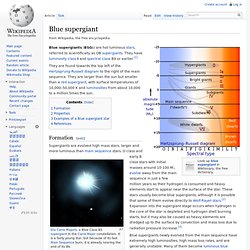
They have luminosity class I and spectral class B9 or earlier.[1] They are found towards the top left of the Hertzsprung-Russell diagram to the right of the main sequence. They are larger than the sun but smaller than a red supergiant, with surface temperatures of 10,000–50,000 K and luminosities from about 10,000 to a million times the sun. Formation[edit] Supergiants are evolved high mass stars, larger and more luminous than main sequence stars. Blue supergiants newly evolved from the main sequence have extremely high luminosities, high mass loss rates, and are generally unstable. Supernova. A supernova (abbreviated SN, plural SNe after "supernovae") is a stellar explosion that is more energetic than a nova.
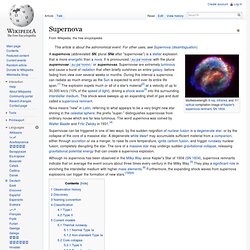
It is pronounced /ˌsuːpəˈnoʊvə/ with the plural supernovae /ˌsuːpəˈnoʊviː/ or supernovas. Supernovae are extremely luminous and cause a burst of radiation that often briefly outshines an entire galaxy, before fading from view over several weeks or months. During this interval a supernova can radiate as much energy as the Sun is expected to emit over its entire life span.[1] The explosion expels much or all of a star's material[2] at a velocity of up to 30,000 km/s (10% of the speed of light), driving a shock wave[3] into the surrounding interstellar medium.
This shock wave sweeps up an expanding shell of gas and dust called a supernova remnant. Nova means "new" in Latin, referring to what appears to be a very bright new star shining in the celestial sphere; the prefix "super-" distinguishes supernovae from ordinary novae which are far less luminous. Luminous blue variable. Luminous blue variables (LBVs) are massive evolved stars that show unpredictable and sometimes dramatic variations in both their spectra and their brightness.
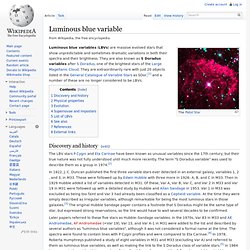
They are also known as S Doradus variables after S Doradus, one of the brightest stars of the Large Magellanic Cloud. They are extraordinarily rare with just 20 objects listed in the General Catalogue of Variable Stars as SDor,[1] and a number of these are no longer considered to be LBVs. Discovery and history[edit] The LBV stars P Cygni and Eta Carinae have been known as unusual variables since the 17th century, but their true nature was not fully understood until much more recently.
The term "S Doradus variable" was used to describe them as a group in 1974.[2] In 1922, J. Hypergiant. Comparison of a blue hypergiant, yellow hypergiant, red supergiant, and red hypergiant superimposed on an outline of our solar system.
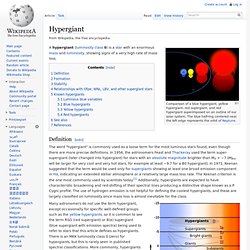
The blue half-ring centered near the left edge represents the orbit of Neptune. A hypergiant (luminosity class 0) is a star with an enormous mass and luminosity, showing signs of a very high rate of mass loss. Definition[edit] The word "hypergiant" is commonly used as a loose term for the most luminous stars found, even though there are more precise definitions. In 1956, the astronomers Feast and Thackeray used the term super-supergiant (later changed into hypergiant) for stars with an absolute magnitude brighter than MV = −7 (MBol will be larger for very cool and very hot stars, for example at least −9.7 for a B0 hypergiant). Hypergiants Formation[edit] Stars with an initial mass above about 25 M☉ quickly move away from the main sequence and increase somewhat in luminosity to become blue supergiants.
Yellow hypergiant. This artist’s animation shows the yellow hypergiant star HR 5171.
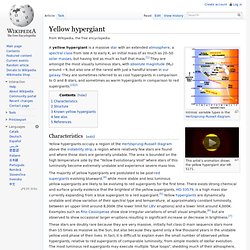
A yellow hypergiant is a massive star with an extended atmosphere, a spectral class from late A to early K, an initial mass of as much as 20–50 solar masses, but having lost as much as half that mass.[1] They are amongst the most visually luminous stars, with absolute magnitude (MV) around −9, but also one of the rarest with just a handful known in our galaxy. They are sometimes referred to as cool hypergiants in comparison to O and B stars, and sometimes as warm hypergiants in comparison to red supergiants.[2][3] Characteristics[edit] Yellow hypergiants occupy a region of the Hertzsprung-Russell diagram above the instability strip, a region where relatively few stars are found and where those stars are generally unstable. The area is bounded on the high temperature side by the "Yellow Evolutionary Void" where stars of this luminosity become extremely unstable and experience severe mass loss.
Largest ever yellow star is 1300 times bigger than sun - space - 12 March 2014. [1401.2628v2] The yellow hypergiant HR 5171 A: Resolving a massive interacting binary in the common envelope phase. Wolf–Rayet star. Hubble Space Telescope image of nebula M1-67 around Wolf–Rayet star WR 124.
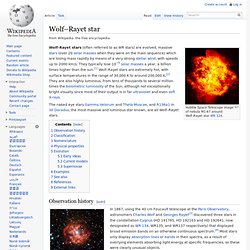
Wolf–Rayet stars (often referred to as WR stars) are evolved, massive stars (over 20 solar masses when they were on the main sequence) which are losing mass rapidly by means of a very strong stellar wind, with speeds up to 2000 km/s. They typically lose 10−5 solar masses a year, a billion times higher than the sun.[1] Wolf–Rayet stars are extremely hot, with surface temperatures in the range of 30,000 K to around 200,000 K.[2] They are also highly luminous, from tens of thousands to several million times the bolometric luminosity of the Sun, although not exceptionally bright visually since most of their output is in far ultraviolet and even soft X-rays.
The naked eye stars Gamma Velorum and Theta Muscae, and R136a1 in 30 Doradus, the most massive and luminous star known, are all Wolf–Rayet stars. Observation history[edit] M1-67 is the youngest wind-nebula around a Wolf-Rayet star, called WR124, in our Galaxy.